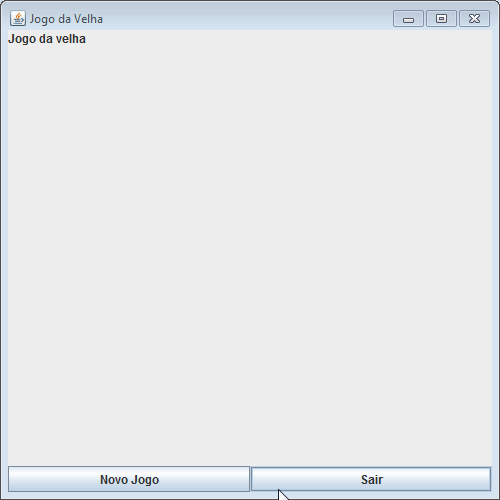2
I’m doing an old game and I’d like to know if the button pressed that I set in class MenuPrincipal is returning the correct value to the main class that controls the change between windows.
Normally running the program does not work, but when placing a breakpoint on line 16 of the main class on the line if(menu.botao), and put to debug in Eclipse the program runs in the correct way.
Main method:
import javax.swing.JFrame;
import javax.swing.JOptionPane;
import interfaceMenu.MenuPrincipal;
public class main {
public static void main(String[] args) {
MenuPrincipal menu = new MenuPrincipal();
menu.setDefaultCloseOperation(JFrame.EXIT_ON_CLOSE);
menu.setSize(500, 500);
menu.setVisible(true);
//JOptionPane.showMessageDialog(null,menu.getOpcao());
while(true) {
if(menu.botao) {
System.out.println("botao apertado");
switch (menu.getOpcao()) {
case "Novo Jogo" :
System.out.println("Botao Novo jogo apertado"); break;
case "Sair":
System.out.println("Botao Sair apertado");break;
default: System.out.println("nada");
}
menu.setOpcao("Nada selecionado");
}
}
}
}
Menuprincipal class:
package interfaceMenu;
import java.awt.BorderLayout;
import java.awt.GridLayout;
import java.awt.Menu;
import java.awt.event.ActionEvent;
import java.awt.event.ActionListener;
import javax.swing.JButton;
import javax.swing.JFrame;
import javax.swing.JLabel;
import javax.swing.JOptionPane;
import javax.swing.JPanel;
import javax.swing.JTextArea;
public class MenuPrincipal extends JFrame {
private final JLabel textoInicial = new JLabel("Jogo da velha");
JPanel areaDosBotoes = new JPanel(new GridLayout());
private JButton[] botoes = new JButton[2];
private String opcao = "Nada selecionado";
public boolean botao = false;
public MenuPrincipal() {
super("Jogo da Velha"); // Barra de titulo;
botoes[0] = new JButton("Novo Jogo");
botoes[1] = new JButton("Sair");
//TODO: MAIS OPÇÕES
areaDosBotoes.setLayout(new GridLayout(1, botoes.length));
for (JButton botao : botoes) {
areaDosBotoes.add(botao);
botao.addActionListener(new TratadorDeEventos());
add(textoInicial, BorderLayout.NORTH);
add(areaDosBotoes, BorderLayout.SOUTH);
}
}
private class TratadorDeEventos implements ActionListener {
@Override
public void actionPerformed(ActionEvent arg0) {
setOpcao(arg0.getActionCommand());
botao = true;
//JOptionPane.showMessageDialog(null, getOpcao());
}
}
public String getOpcao() {
return this.opcao;
}
public void setOpcao(String opcao) {
this.opcao = opcao;
}
}

You’re mixing graphical interface with text mode, maybe that’s the reason.
– user28595
The problem persists even using Joptionpane.showMessageDialog instead println there in the main class
– Rafael
From the moment the boot is tightened, it will be eternally true, and its loop will never stop running.
– user28595
I don’t know what is the point of using text mode in graphical interface, and what is the use of this infinite loop that never stops, but Oce needs to define the moment when the loop should be finished, otherwise it will never leave the loop.
– user28595
Yes, I forgot, after pressing button, set if the boot was pressed to false, but still it should at least work at first run, right? I’ll fix it from the ever true button
– Rafael
This loop will be finished when the exit button is pressed, however I first need to know if the main class is getting the correct button pressed option
– Rafael
Your logic is wrong, swing by itself is already an API that runs under a loop, you are adding another and this will lock the application, I suggest q remove this loop, it is not necessary for the interface to work, alias, it will mess up. Try removing all the code from while and you’ll see, the screen doesn’t need this loop. If you want to control the buttons pressed, you’re doing it the wrong way.
– user28595
then, what would be the correct way to control the button pressed?
– Rafael
Within the actionlistener.
– user28595
Why did you undo my editing? I had no reason to, I just improved some of the text, I didn’t change anything.
– user28595